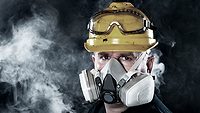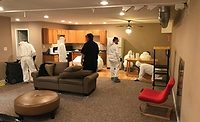The Use of Primers in Restoration

One of the most misunderstood and underappreciated products in the paint and coatings market is a primer. What a primer is designed to do and what is expected of it can be a topic for discussion for homeowners/customers and contractors alike.
A primer is a coating that is carefully formulated to adhere well, fill surface voids, and possibly seal in stains and odors when applied to a surface. Surfaces may be concrete, wall board, various woods, composites, metals, and plastics. A primer that meets the design criteria enables a decorative topcoat to lay out smoother, not flake or scratch off, and generally be more attractive on these surfaces.
Basic Formulations
All primer coatings are formulated with four basic groups of raw materials: 1) resins, 2) colorants and fillers, 3) solvents such as alcohols, hydrocarbons, and water, and 4) additives including defoamers, surfactants, pH adjusters, and thickeners.
Resins provide durability and adhesion to the substrate. They are the backbone of the formulation. Colorants are exactly what the name implies – pigments that impart the desired color. Fillers usually provide solids that result in a higher build (thicker dried film) but can influence important properties of the dried film. Solvents have much to do with the resin type and the drying rate of the coating. Additives have a variety of functions from preventing air bubbles (foam) to wetting and leveling to the viscosity of the coating.

Types
Primers generally fall into one of the following categories.
Shellac: These primers use a resin produced by lac bugs in Southeast Asia as the main resin. Primers of this type exhibit good stain blocking as well as sealing in odors. The solvents used to solubilize shellac are usually alcohols which result in considerable odor during application and drying as well as high VOC levels. Additionally, the volatility of the solvents results in a low flash point and a flammable label.
Oil-Base: Primers of this type are formulated with a variety of resin types intended to mimic the performance of shellac without the expense and supplies issues associated with it. Typically, hydrocarbon solvents are used to solubilize the resin which makes the primer have considerable odor, have high VOC levels, and a flammable label.
Water-Base: This group of primers is usually formulated with acrylic or modified acrylic resins intended to again mimic the performance of shellac. These primers are usually low odor and usually have a VOC level. The minimum amount of solvents included in the formulation results in products that are non-flammable and much safer to use.

Applications
Not all primers are intended to provide the same properties. Some are designed to block tannins and water stains while others are designed as a sizing for new wall board or provide adhesion to metals. There is no one primer that meets all the performance characteristics of all jobs. For that reason, careful selection of the appropriate primer is necessary. Primer studies by major paint manufacturers have consistently shown increased performance on various substrates when an appropriate primer is used.
The primer is best applied to a new or well-prepared area as a thin, uniform coating that completely covers the desired area of substrate. The coating should be allowed to air dry before a topcoat is applied. The dry time or recoat time is usually specified on the primer container label or in a Technical Data Sheet provided by the manufacturer.
Trends
A relatively recent addition to the menu of primers are products marketed as paint and primer in one. This appears to make selection of appropriate products for your job much easier as one or two coats of the same product is all that is needed. However, these products may poorly prime the substrate or result in a final appearance that is less than desired.
Changes in state and regional regulations that lower the maximum allowable solvent emissions has resulted in a variety of low VOC (volatile organic compound) water-based primers touted to perform similarly to the solvent versions. These water-base products should be evaluated on the specific application to determine actual performance.

Selection
The best approach to selecting the appropriate primer for your application is to determine the variables that will affect the coating and what final properties are desired. Variables may include such things as substrate type, desired resistance, exposure to weather, surface preparation, topcoat type, air temperature and humidity, and ventilation.
Selection of the best primer for your application may seem daunting but read the product container label for advice and contact the retailer, distributor, or manufacturer for assistance. Proper primer selection for a job will result in a final appearance that is both pleasing to the eye and one that will last for years.
Looking for a reprint of this article?
From high-res PDFs to custom plaques, order your copy today!








